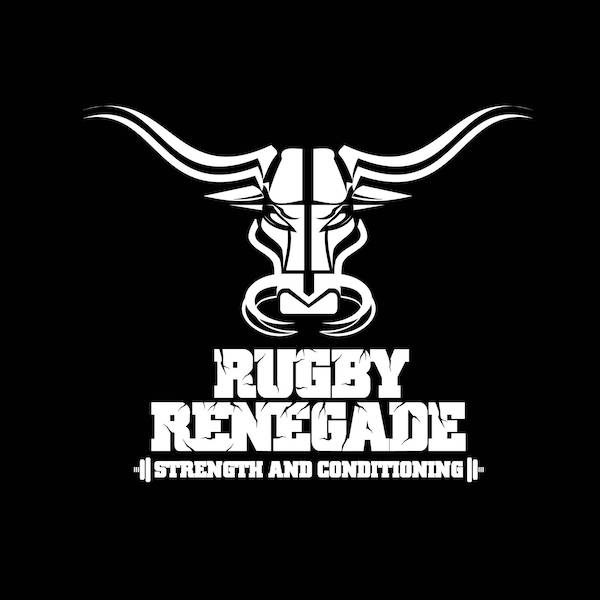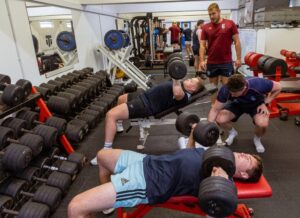‘Power is a key component for any Rugby Player’.
‘Power is a product of STRENGTH!’
The greater maximal strength a player possesses, the higher the potential for power to be developed. Power is the rate in which a player can perform work. It is a product of strength and speed and is essential to all athletes, not just rugby players. Rugby players, require the ability to perform powerful movements over and over again during a match. This is where power endurance also becomes important. Actions such as jumping, tackling and sprinting all require significant amounts of power.
Gains in power do not occur all at once, but rather cumulatively and in a certain sequence. Furthermore, the development of power is achieved by following a very specific training process organized in specific training phases. This important training process is called periodization of strength (Bompa, 2006; Bompa, 1999).
Periodization is the planned organisation of training, practice, competition and rest and recovery into blocks or periods throughout a given period of time. The organisation, placement and content of the training blocks are governed by the phase of the season (off/pre/in) and its competition structure (games/competition schedule).
The mesocycles for Strength Training in Rugby are as follows…
- Transitional Phase (Off Season)
- General Preparation Phase (Pre Season – Block 1)
- Sports Specific Phase 1 (Pre Season – Block 2)
- Sports Specific Phase 2 (Pre Season – Block 3)
- Competition Phase (In Season)
Off Season – Transitional Phase
Traditionally the Off Season has been a period of complete rest, however, this phase is a crucial part in any rugby players development. It is important that any ongoing injuries are addressed and treated, as well as a period of relaxation and time away from rugby.
In order to reduce the monotony of training, gym based sessions are encouraged to be conducted unsupervised away from the training facility (Gamble 2006), with less emphasis on big compound and technical lifts that require corrective feedback.
During this phase the player’s will undergo a process known as general adaptation syndrome, GAS. This phase should be seen as an opportunity for the player to participate in lower intensity activities and aims to progressively prepare each player for future cycles and the stresses associated with training. It is essential the player consults their team physio prior to the start of their Off Season cycle to ensure any previous or potential injury is identified.
The main concerns from an injury prevention perspective should be continuing prehab/rehab exercises for previous injuries sustained, as well as, addressing potential injuries that may have been spotted through movement patterns seen in gym based sessions that may have resulted in compensatory movement patterns and consequently leading to injury. The program should emphasise exercises to enhance the players ability to stabilize the spine and lower limbs and provide mobility at the hip and shoulder girdle to minimize common injuries to ankles, knee’s and shoulder’s seen in rugby. This should occur through ensuring the player possesses similar strength levels in both horizontal and vertical pushing and pulling actions. Similarly the athlete must possess similar control in knee (Squatting) and hip dominant actions (deadlifting). The length of this cycle may differ dependent on the level and movement quality of the players and generally lasts 2-4 weeks and may contain 3 sessions per week.
Gym based training sessions should involve a number of different exercises, that multi planar in nature, based on assessment results and may involve a number of bodyweight type exercises such as push up, chin ups, and more unilateral and posterior chain movements like lunges, step ups, good mornings and single leg Romanian deadlifts. Minimal emphasis should be put on sport specific strength but more on general athleticism. Sets and Repetitions should range from 3-4 sets of 10-20 at an intensity of 50-65% 1RM.
Preseason Block 1 – General Preparation Phase
With the growing level of physicality involved in the modern game, increasing muscle mass is essential to be successful and prevent injuries. Hypertrophy training is based on the theory of increasing the cross sectional area, CSI of the players muscles. Muscular strength is proportional to CSI and therefore, the aim of the hypertrophy cycle is to increase the player’s lean muscle mass and in effect produce greater force during the later stages of the training program.
During this cycle players should focus predominately on key compound (multi joint) exercises such as Clean Pulls, Bench Press, Squats and Deadlifts as well as isolation exercise that can be used for assistance work (Chest Flyes, Tricep Extensions). Again the focus along with muscle gain should be on maintaining or correcting muscle imbalances and ensuring the player’s are lifting through full ranges of motion (ROM) and using multi directional actions. See our Rugby Renegade Article of the benefits of the full R.O.M in the Squat… https://rugbyrenegade.com//the-cornerstone-to-any-rugby-strength-programme-the-squat/
The volume and intensity during this period should be greater than during the Transitional Phase with sets and reps ranging from 3-4 sets per exercise of 8-12 Reps at 65-80% of 1RM. The cycle should last between 4 and 6 weeks and the players should lift 3-5 times per week.

Preseason Block 2 – Sports Specific Phase 1
Maximal Strength is the ability to produce the most amount of force against an external resistance. Rugby involves fierce body contact at regular intervals combined with explosive force generation due to the sheer size and body mass of each player as well as an increased knowledge of, and greater training focus on spinal stability and core strength which in turn leads to greater body control, awareness, balance and muscular endurance (Meir, 2001).
Strength is therefore the single most important facet of the game and is a major ingredient for the production of power. Maximising a player’s strength level will help to overcome the loads and forces associated with the game. Strength levels are maximized through performance of multi joint lifts, such as bench press, squats, deadlifts, Olympic lifts along with various other tools, i.e. sleds and odd shaped heavy implements used in strongman type training as these replicate the action of tackling and the maul in rugby.
The volume and intensity during Sports Specific Phase 1 should range from 3-6 sets of 2-6 Reps at 80-95% 1RM. Due to the fatigue and neural stress associated with heavy lifting rest period should be 2-4 mins in length. The strength cycle should last 4-6 weeks dependent on level of player and training age.
Preseason Block 3 – Sports Specific Phase 2
This phase aims to “convert” the hypertrophy and strength gains from preceding cycles into sport specific performance through power based training. Power is the ability to produce maximal force in the least amount of time. It is during this period in the training cycle that volume is low to (3-4 sets of 2-6 reps), but intensity and effort should be near maximal. Loads lifted are generally ranging from around 50-75% 1RM but the emphasis is on the speed of contraction and hence the players must focus on lifting as fast and forceful as possible. It is during this phase, a greater emphasis is placed on position specific training. In general for most playing positions, the majority of force produced is horizontally distributed and therefore training should focus on this aspect. 
It is a common method during power or speed strength phases for strength coaches to use complex training methods, with great results. Complex or combination training involves performing a maximal lift such as front squats, followed by a plyometric exercise such as jump squats.
In Season – Competition Phase
In season it’s imperative for the players to maintain the work carried out during the off season and preseason but due to the length of the rugby season its vital that players continue to develop as strength/power athletes. Training sessions during in season should focus on high intensity strength training workouts emphasizing maximal strength and power and to a lower extent, muscular endurance. Teams should perform 2-3 sessions per week in season to ensure this maintenance occurs and sets and reps should range from 3-4 sets of 2-6 Reps at 80-95% 1RM. Training days during this period are influenced by the day of the game, an example may be a Saturday game followed by a Friday game the next week.
Rugby players at all levels must endure enormous amounts of physical contact or force and therefore must be able to resist and overcome these forces to be successful. This is why it is essential for all players to possess a sufficient level of strength, stability and explosive power.
From our Rugby Renegade Daily Training Program provided via our website, the aim is to empower players with the knowledge and to understand the importance of what they do in the gym will have a big impact into on field performance.





